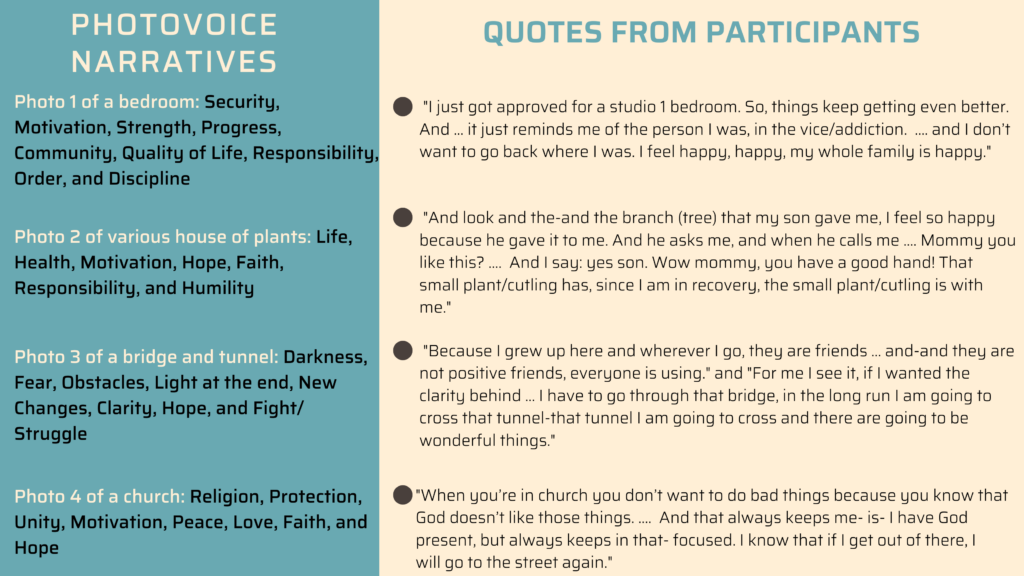In 2021, Latine1 individuals made up 12.8% of the Massachusetts population but represented 38% of opioid-related deaths in the state. Factors including lack of access to culturally relevant and linguistically appropriate services and stigma related to drug use might have contributed to this disproportionate harm. One way to counteract these factors is to engage Latine individuals in the addiction research process. Research approaches such as photovoice amplify the voices of marginalized populations. This week, STASH reviews a study by Jordana Muroff and colleagues that examined the use of photovoice to engage Latine, Spanish-speaking individuals in recovery from a substance use disorder (SUD) by using photography and narration to illustrate their experiences and promote policy change.
What was the research question?
What was the outcome of the photovoice project that emerged as a result of collaboration among Latine, Spanish-speaking individuals in recovery from SUD?
What did the researchers do?
The authors recruited a non-probability sample of 13 adult, Spanish speakers from CASA-CHESS, a Boston University program adapted for Latine, Spanish-speakers that used a smartphone application (i.e., mHealth) to promote health, wellness, and recovery among adults with SUD. Participants engaged in 3 sessions over a 6-week period with a goal of creating a photovoice demonstration, highlighting factors that influenced their recovery outside the treatment setting. Participants (1) took photos of aspects of their life that they felt most influenced their recovery, (2) reflected upon the images and analyzed themes that emerged, and (3) constructed a narrative that gave meaning to each image. Finally, the group determined a name for the photovoice project, a medium for presenting it, and brainstormed stakeholders to share the project with.
What did they find?
Participants entitled their photovoice “Nuestra Recuperación” or “Our Recovery,” representing their sense of community connection and hope. Participants also devised four narratives, one for each photo (see Figure), finding that motivation, hope, and community were primary themes across their recovery narrative. Participants went on to share more specific thoughts about recovery, including the importance of housing, family/friends, a sense of responsibility and hope, and faith-based community support (see Figure). Participants chose to disseminate their finished photovoice project by (1) printing out the photos and corresponding narratives and hanging them in their local community health center and (2) sharing a slideshow of the results on the mHealth app to reach a broader audience. This project was not only successful in empowering individuals by giving them the opportunity to share their recovery experiences with one another and the broader community but also resulted in organizational change within the community. Specifically, since this project, more providers at the participant treatment clinic have introduced photovoice as a therapeutic tool.

Figure. Photovoice narratives established by participants along with quotes from participants that expand upon their reasoning for choosing these narratives. The photos used in this project can be found in the original (open access) research article, Muroff et al. (2023). Click image to enlarge.
Why do these findings matter?
Substance use research tends to focus on individual factors that impact recovery, such as an individual person’s history of mental health concerns. Though these individual factors are important, the photovoice project teaches us that it is equally important to pay attention to community- and structural-level recovery resources, such as churches, housing supports, and community centers, especially among groups of people who highly value collectivism. Towns and cities should form paid advisory boards to learn more about their community members’ recovery and wellness needs.
Every study has limitations. What are the limitations in this study?
The sample size was small with only 13 people. Before partaking in this study, participants might have already been familiar with one another. Because of this and the discussion-based nature of the project, participant responses were subject to response bias, reflecting back what they thought others were already thinking rather than contributing their original thoughts.
For more information:
If you are worried that you or someone you know is experiencing addiction, the SAMHSA National Helpline is a free treatment and information service available 24/7. For more details about addiction, visit our Addiction Resources page.
— Nakita Sconsoni, MSW
What do you think? Please use the comment link below to provide feedback on this article.
________________
[1] Latine (pronounced la·ˈti·ne) is a gender-neutral form of the words “Latino” and “Latina” and we are using it here to be inclusive of all gender identities, including non-binary people. The words “Latine” and “Latinx” can be used interchangeably, but Latine is a more natural pronunciation for Spanish and Portuguese speakers.




